

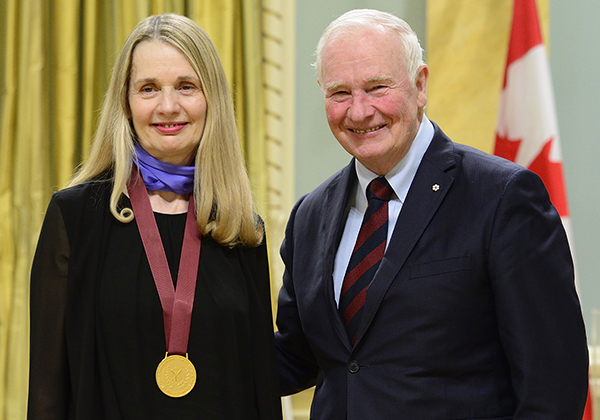
Merna Forster receives her Governor General's History Award for Popular Media (Pierre Berton Award) from Governor General David Johnston in November 2016. Photo credit: Sgt Johanie Maheu, Rideau Hall, © OSGG
The long road to gender equity can sometimes feel more like a treadmill these days. Just ask Merna Forster, '76 BA(Spec), a Governor General award-winning historian, whose long-time mission has been to champion women in Canadian history.
In 2004, Forster published her first book, 100 Canadian Heroines: Famous and Forgotten Faces, showcasing little-known women from our history. In the same month the book hit stores, the CBC announced the results from its The Greatest Canadian television quest. No women made it to the top 10, and only a handful to the top 50. (The highest ranked woman was singer-songwriter Shania Twain.) That same year, the Supreme Court of Canada ruled that the Government of Newfoundland and Labrador was justified in deferring pay equity to women during a financial crisis. We've come so far since then, right?
Not really.
In 2011, the Bank of Canada replaced the only Canadian women depicted on our banknotes - the Famous Five and Quebec feminist and politician Thérèse Casgrain on the $50 bill - with the image of … an icebreaker? Forster wasn't having it. She started writing letters: to newspapers, to politicians, to the Bank of Canada governors. She launched an online petition and an interactive website, inviting people to mock up virtual banknotes featuring the faces of worthy women.
"There was a mixture of rage and disbelief that this was even a matter of discussion," Forster says of the reaction of online commenters and supporters.
Her petition ultimately garnered 73,000 signatures, and the Bank of Canada conceded. Forster was appointed to a federal advisory committee to choose from among more than 26,000 remarkable women nominated by the public. This past December, black civil rights activist Viola Desmond was chosen to be the first Canadian woman featured on the Canadian $10 bill. Thanks in part to Forster's persistence, Desmond's face (and her extraordinary story) will be found in every corner of this country when the new banknote is released in 2018.
For Forster, of course, her work is about much more than banknotes. She devotes herself to advocacy work, presenting on her research about women's roles in shaping Canada's history, pushing for curriculum reform and securing wider distribution of her books in public schools and libraries across the country. It's about contributing to a larger conversation about women's rights, representation and equity.
"Women hold up half the sky," says Forster, "they should certainly hold up half the banknotes, half the positions of influence and half the seats of parliament."
Not your father's top 10 list
Viola Desmond is just one of thousands of Canadian women who've shaped our nation's history. In celebration of Canada 150, here's a list of 10 other remarkable women noted in Forster's books - 100 Canadian Heroines: Famous and Forgotten Faces and 100 More Canadian Heroines. Share your favourite heroines in the comment section below.
The Conductor
Who: Ethel Stark (1910-2012)
Top achievement: Stark started the Montreal Women's Symphony Orchestra in 1940 and acted as its conductor for 20 years.
Why it matters: She raised the profile of women in music by providing them opportunities to perform.
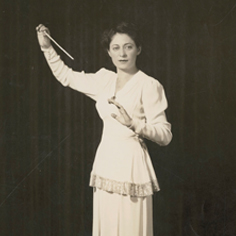
The Chief
Who: Elsie Knott (1922-1995)
Top achievement: In 1952, after the Indian Act was amended to allow women to become officially involved in band politics, Knott was elected the first female chief of a First Nation band. She served a second term from 1970 to 1976.
Why it matters: During her terms as chief, Knott secured funding to improve infrastructure and social services for her people, the 500 Mississaugas of Mud Lake Indian Band, now known as Curve Lake First Nation. Her personal and political work uplifted her whole community.
The Pilot
Who: Helen Harrison (1909-1995)
Top achievement: Harrison was the first Canadian woman to fly for the Air Transport Auxiliary in Great Britain during the Second World War.
Why it matters: Harrison achieved a number of firsts in Canadian aviation, helping to pave the way for other women in the industry.
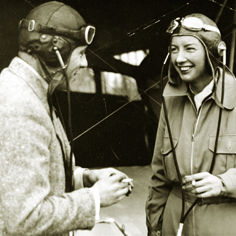
The Scientist
Who: Leone Norwood Farrell (1904-1986)
Top achievement: Farrell helped develop a technique to mass-produce the polio vaccine, enabling Jonas Salk and his team to perform the initial polio vaccine trials in 1954.
Why it matters: Her role in eradicating polio helped save millions of lives around the world.
The Preserver
Who: Shanawdithit (ca. 1801-1829)
Top achievement: Shanawdithit was among the last of the Beothuks, the Indigenous people of the island of Newfoundland, who were eventually driven to extinction after the arrival of Europeans. She helped document the history of her people.
Why it matters: Without Shanawdithit's sketches and stories of the Beothuks' way of life, little would be known about them today.
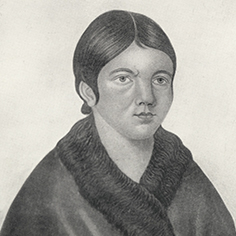
The Journalist
Who: Muriel Kitigawa (1912-1974)
Top achievement: Through her writing, Kitagawa condemned the racist policies that led to Japanese Canadians being named enemy aliens following the bombing of Pearl Harbour.
Why it matters: Her protests against the internment of Japanese Canadians in the 1940s inspired others to speak up, raised awareness of the injustices and helped build the movement toward redress.
The Founder
Who: Jeanne Mance (1606-1673)
Top achievement: Mance helped found North America's first hospital, Hôtel-Dieu de Montréal, where she worked as director and Canada's first secular nurse.
Why it matters: She played a prominent public role in what would become one of the world's great cities. Hôtel-Dieu is still in operation, three centuries later.
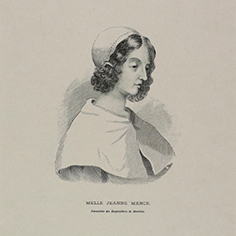
The Hockey Player
Who: Hilda Ranscombe (1913-1998)
Top achievement: Described by some as the Wayne Gretzky of women's hockey, Ranscombe was captain of Ontario's Preston Rivulettes - one of the most famous women's hockey teams in Canadian history.
Why it matters: She elevated the reputation of women's hockey and opened the door for other women to play.
The Guide
Who: Taqulittuq (Tookoolito) (ca. 1838-1876)
Top achievement: Taqulittuq served as a guide and interpreter to Arctic explorers, most notably Charles Francis Hall in the search for Franklin's lost expedition in the 1860s and 1870s.
Why it matters: Her service facilitated Hall's Arctic explorations and enabled him to collect oral history data and artifacts of the Franklin expedition.
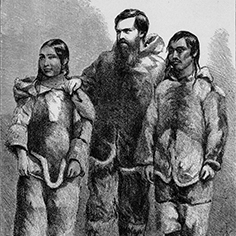
The Rebel
Who: Marie-Joseph Angélique (ca. 1709-1734)
Top achievement: Angélique, a young black slave in New France, rebelled against slavery and tried to escape from her bondage.
Why it matters: She was tortured and executed for allegedly setting her owner's home on fire, subsequently burning down a large portion of what is now referred to as Old Montreal. While it remains unclear whether or not she committed the crime, Angélique is considered a hero for this act of defiance against slavery in Canada.
Test your knowledge
Want to learn more about awesome women in Canadian history? Check out Merna Forster's books - 100 Canadian Heroines: Famous and Forgotten Faces and 100 More Canadian Heroines - or her website, where you can find quizzes to test your knowledge.
Comments Policy
We at Thought Box welcome your comments. Robust debate and criticism are encouraged, provided it is respectful. We reserve the right to reject comments, images or links that attack ethnicity, nationality, religion, gender or sexual orientation; that include offensive language, threats, spam; are fraudulent or defamatory; infringe on copyright or trademarks; and that just generally aren't very nice. Discussion is monitored and violation of these guidelines will result in comments being disabled.
We at New Trail welcome your comments. Robust debate and criticism are encouraged, provided it is respectful. We reserve the right to reject comments, images or links that attack ethnicity, nationality, religion, gender or sexual orientation; that include offensive language, threats, spam; are fraudulent or defamatory; infringe on copyright or trademarks; and that just generally aren’t very nice. Discussion is monitored and violation of these guidelines will result in comments being disabled.